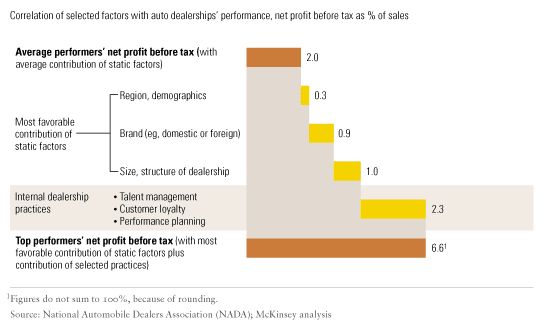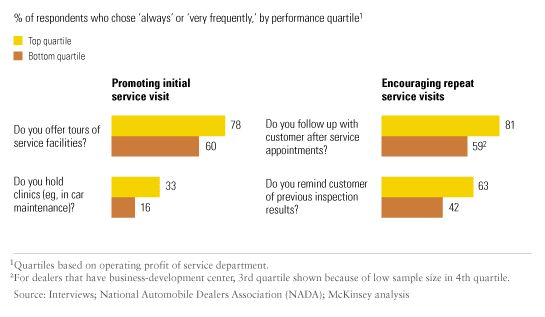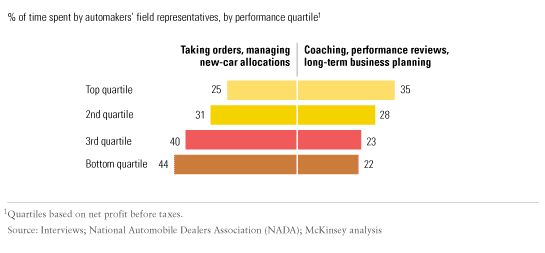In the United States, automakers rely on franchised dealers for virtually all new-car sales and for providing parts and service to car buyers. The performance of dealerships therefore has a significant impact on the automakers’ profitability. A survey of US auto dealerships finds that top performers are more than three times as profitable as average ones and highlights three ways in which top dealerships distinguish themselves. Our study suggests that automakers should investigate ways of collaborating more with dealers to improve their performance, because both parties appear likely to reap substantial benefits from such efforts.
To understand what separates the best dealerships from the rest, we conducted 15 in-depth interviews with high performers and then surveyed more than 700 owners and general managers to assess their operational practices.1 Next, we compared the responses of the dealers with their key financial metrics2 and evaluated different practices to investigate the correlation with performance. The study showed a strong correlation between certain practices and the financial results of dealers and confirmed our experience that operational and other practices can substantially affect the performance of dealerships.
We expected that certain static factors largely outside the immediate control of dealers would influence their profitability—and indeed we found that the brand they sell, their size, and the demographic characteristics of the markets they serve correlated positively with net profits. However, half of the difference in profitability that we observed between high- and average-performing dealerships was correlated with factors more immediately under their influence (Exhibit 1). The results suggest that even dealers with few structural advantages (such as a flourishing brand or a large market area) can hope to increase their net profits significantly. Three areas in particular stood out.
Better practices, bigger profits

The first is talent management. High employee turnover plagues many car dealerships, yet our survey’s top performers had turnover rates that were 17 percentage points lower than those of dealers in the bottom quartile (54 percent versus 71 percent, respectively). When we looked further we found that top dealerships were more likely to indicate that they used formal, consistent talent-management practices, such as structured recruiting processes with a number of interviews for each candidate. Likewise, top dealerships were more likely to provide formal training to their employees (57 percent versus 40 percent of the poor performers) and to use long-term incentives to retain top talent. By contrast, high-ranking managers at average- and poorly performing dealers focused less attention on recruitment and frequently weren’t even directly involved in hiring decisions.
Second, we found that some dealers don’t appear to be paying enough attention to practices that could help them increase their customers’ loyalty. Although 78 percent of the top dealerships offered car owners tours of service facilities, for instance, only 60 percent of the low performers did. Moreover, 63 percent of top dealerships encouraged repeat service visits from customers by sending them reminders about the results of previous inspections, as opposed to only 42 percent of the poor performers (Exhibit 2). In our experience, focusing on improvements in the service department to win more repeat customers can help dealerships increase their profitability and reduce both their own and the automakers’ customer acquisition costs.
Service with a smile

Third, we found that the amount of time an automaker’s field staff spends planning for the future and reviewing the business performance of dealerships is correlated with dealership profitability. Respondents at poor performers indicated that the automakers’ field representatives spent only 22 percent of their time reviewing the dealers’ performance and offering suggestions for improvement (and 44 percent taking orders for vehicles and allocating new cars to the dealers). By contrast, top performers indicated that the automakers’ field reps spent more of their time on coaching and long-term business planning (Exhibit 3).
Spending time wisely

Although dealerships could do more to improve their operations, our study suggests a larger role for automakers as well—particularly when it comes to understanding the specific situations that dealers face. In fact, nearly two-thirds of those we surveyed complained that their automakers’ representatives lacked the required knowledge to improve their operations. Our experience shows that when the field staff of an automaker knows about the competitive threats its dealers face—and has concrete suggestions for addressing them—the automaker enjoys greater credibility. Attempts to improve the dealerships’ operations will work only if automakers overcome these relationship and credibility issues. For many automakers, better training for the field staff would be an important first step. The rewards can be worthwhile. Fully 58 percent of the top-performing dealers we surveyed met or exceeded the new-vehicle sales goals their automakers set; only 36 percent of low-performing dealers did.